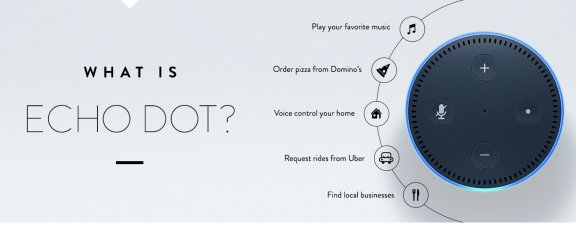Alexa, would you marry me?

It has been almost a month since I came back from the fifth edition of re:Invent—the main Amazon Web Services conference held in Las Vegas each year—and I take it upon myself to go ahead and bother you with a take-away post heavily influenced by my personal interest in the Internet of Things and, to a higher degree, smart home technologies.
Have an Echo Dot on the house
With an Amazon Echo Dot for swag to the 30,000+ participants, an Alexa smart home booth in the expo hall and sessions with names like Capital One, Intel, Boston Children’s Hospital there was no doubt Amazon was, from the conference first day to the last, going to focus and ramp up its promotional efforts on its voice-activated speakers and the known or to be announced services that power them—one could not help but notice the release of the Google Home the same very month.
The Amazon Echo, its little brothers and sisters would be useless pieces of hardware (low-quality portable speakers at best) if they did not have skills and did not get new skills on a daily basis: with more than 4,000 skills the Alexa ecosystem is rapidly growing. These capabilities allow customers to interact with their devices using voice commands and follow, long story short, a basic request (you invoke a skill and formulate an intent) - response (Alexa replies) pattern with lots of magic in between.
Magic? Learn a few tricks
Getting started with the Alexa Skills Kit is quite straight forward and having an end-to-end simple but working Alexa custom skill a matter of minutes (see lroguet/amzn-alexa-skill-demo on GitHub for a Node.js skill template).
An Alexa skill can be hosted either as a web service or on AWS Lambda and I would suggest you look into the second option to begin with. Again, Amazon Web Services is giving the Alexa ecosystem the attention it (finally) deserves and announced a new partner program: the Alexa service delivery program for partners, and not directly related to Alexa I must admit, a new certification for partners: the IoT competency.
If you are unsure where to begin there are plenty of professional services firms in the Amazon Web Services Partner Network (APN) that could help you get started and Nordcloud—my employer as I write these lines—is one of them. May I suggest, for example, you begin with one of the AWS instructor-led trainings I will deliver in Copenhagen, Helsinki, Stockholm or Oslo in 2017?
The Amazon AI umbrella
A new AI platform and three new services is what was announced during the event’s first keynote: Amazon Rekognition, Amazon Polly and, last but not least, what’s inside Alexa–Amazon Lex.
Amazon Lex is a new service for building conversational interfaces using voice and text. The same conversational engine that powers Alexa is now available to any developer, making it easy to bring sophisticated, natural language ‘chatbots’ to new and existing applications. The power of Alexa in the hands of every developer, without having to know deep learning technologies like speech recognition, has the potential of sparking innovation in entirely new categories of products and services. - Bringing the Magic of Amazon AI and Alexa to Apps on AWS
While I have not had the time to play with any of these services yet, I already have a few home project ideas but also feature ideas to try out with customers as soon as possible next year!
Can we get some more please!
Participants are now back to their respective employers and some of them already looking into adding voice—starting with an Alexa skill—as yet another user interface to their product(s). While this looks exciting and likely to make life at the office a bit more fun on paper, a number of teams already came back to reality as they realized they cannot get their hands on hardware.

That’s right. Amazon’s Alexa-enabled devices are currently only available for delivery in the U.S and in the U.K which leaves out 194 countries (if you consider Taiwan a country). You might argue that one could develop a skill without dedicated hardware and use a web-based interface like Echosim.io to interact with Alexa. Granted. But how sexy is that in a demo to other teams or, more importantly, a demo to those who have the power (read money) to turn prototypes into products?
One would think Amazon Web Services had considered the issue but as far as I know even branch offices—in Scandinavia at least—cannot help acquire hardware. Customers are on their own and left with nothing to work with: quite an interesting situation the Earth’s Most Customer-Centric Company has put itself into.
So. Would you marry me?
Amazon definitely put a lot of emphasis on voice recognition—whether through Alexa enabled devices or purely as services of the AI platform—but there are still a few things to iron out before the technology gets real traction. Availability is, as far as I, and a few customers of mine I talked to since the event, am concerned, a major issue that needs to be addressed very soon or Alexa will not get much more than the 250,000 marriage proposals she has had so far.
Unless Echo, Echo Dot and the whole gang are released globally the relationship with the 194 other countries might just keep on being what it is today, somewhat distant. Or as Alexa would put it: “Let’s just be friends”.